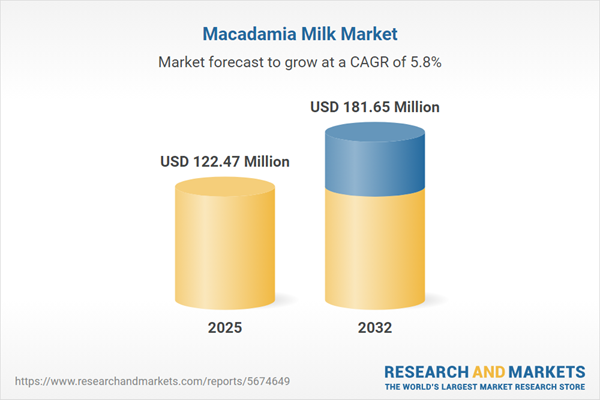Speak directly to the analyst to clarify any post sales queries you may have.
The macadamia milk market is undergoing transformation as enterprises respond to a stronger focus on sustainability, health-driven priorities, and evolving consumer and buyer needs. Senior decision-makers recognize the importance of flexible strategies that leverage plant-based trends to stay competitive within this dynamic beverage segment.
Market Snapshot: Macadamia Milk Market Size and Growth
Macadamia milk is building momentum worldwide, attracting both established brands and new entrants seeking opportunities in health-focused, plant-based beverages. The market is projected to reach a value of USD 116.05 million in 2024 and rise to USD 122.47 million in 2025. Growth is sustained by consumer preference for healthier, innovative alternatives. With a compound annual growth rate (CAGR) of 5.76% anticipated through 2032, sector value is expected to reach USD 181.65 million at forecast conclusion. Organizations are responding through diversification, strategic investments, and distribution enhancement across mature and emerging markets. Digitalization initiatives and advanced technology integration are also supporting scalable operations and improved process efficiency.
Scope & Segmentation of the Macadamia Milk Market
Granular segmentation enables organizations to tailor innovation, market approaches, and brand positioning for diverse audiences within the global macadamia milk market. Adopting a responsive segmentation strategy enhances visibility and helps organizations target high-growth channels.
- Product Types: Options include unflavored, chocolate, vanilla, matcha, turmeric, and berry, facilitating portfolio customization for various commercial and consumer preferences.
- Packaging Types: Solutions such as bottles, cartons, pouches, and sachets balance convenience, product visibility, and shelf life, while furthering sustainability through eco-friendly choices.
- Age Groups: Formulations for adults, children, and seniors support targeted nutrition objectives, assisting partners in retention strategies and enhancing brand attachment across demographics.
- Forms: Liquid and powdered macadamia milk formats address the needs of commercial, institutional, and direct-use segments by offering shelf stability and simplified logistics.
- Distribution Channels: Widespread access is achieved by leveraging supermarkets, hypermarkets, specialty stores, and e-commerce, ensuring reach to foodservice providers, corporate buyers, and end consumers.
- End Users: The sector serves food and beverage brands, restaurants, cafes, and individual customers, supporting both B2B and retail requirements.
- Geographies: Operations span North America, Latin America, Europe, the Middle East, Africa, and Asia-Pacific. Remarkable growth is observed in China, India, Japan, Australia, and South Korea as plant-based preferences accelerate.
- Leading Companies: Competitive participation includes Kikkoman Corporation, Hawaiian Host Group, Patons Group, Giraf Limited, Nam Viet F&B, Noumi Limited, MACA MILK PTY LTD, PlantBaby Inc., Omella Inc., Pacific Foods, Elmhurst Milked LLC, Califia Farms LLC, Nutty Bruce Pty Ltd, MilkLab, MARQUIS MACADAMIAS LTD, Whole Foods Market IP LP, and Jindilli Beverages LLC.
Key Takeaways for Senior Decision-Makers
- Positioning macadamia milk as a wellness and nutrition solution strengthens appeal among procurement teams building health-centric portfolios.
- Sustainable production and eco-conscious packaging can boost reputation and align products with environmental, social, and governance criteria.
- Expanding flavor and functional offerings supports premiumization and enables companies to meet evolving expectations of foodservice and retail buyers.
- Strategic alliances with retail and foodservice operators increase reach and build resilience across both established and emerging channels.
- Implementing sophisticated procurement and transparent supply chain practices supports trust, risk mitigation, and robust supplier and buyer relationships.
Tariff Impact: Navigating Shifting US Import Policies
Recent changes in US import tariffs on nut-derived products have prompted macadamia milk manufacturers to realign sourcing and amplify investment in supply strategies. Market participants emphasizing process optimization and risk mitigation are maintaining stable export channels despite evolving regulations. Adaptable supply chain frameworks continue to be pivotal in ensuring business continuity and reliability amid shifting policy landscapes.
Methodology & Data Sources
This analysis draws from executive interviews, structured literature reviews, and company report examination. Insights are verified using the latest international trade data to provide a credible foundation for effective decision-making in the evolving macadamia milk market.
Why This Report Matters: Strategic Relevance for Stakeholders
- Enables stakeholders to identify effective growth and innovation paths in the plant-based and macadamia milk segment.
- Offers frameworks for regulatory planning and proactive market forecasting at global and regional levels.
- Supports operational resilience and supply chain improvements during industry transition.
Conclusion
Achieving long-term leadership in the macadamia milk market will depend on adaptable sourcing, advanced distribution practices, and continued commitment to innovation. Companies remaining attuned to shifting priorities will be best positioned for continued success.
Additional Product Information:
- Purchase of this report includes 1 year online access with quarterly updates.
- This report can be updated on request. Please contact our Customer Experience team using the Ask a Question widget on our website.
Table of Contents
3. Executive Summary
4. Market Overview
7. Cumulative Impact of Artificial Intelligence 2025
Companies Mentioned
The companies profiled in this Macadamia Milk market report include:- Kikkoman Corporation
- Hawaiian Host Group
- Patons Group
- Giraf Limited
- Nam Viet F&B
- Noumi Limited
- MACA MILK PTY LTD
- PlantBaby, Inc.
- Omella, Inc.
- Pacific Foods
- Elmhurst Milked, LLC
- Califia Farms LLC
- Kikkoman Corporation
- Patons Group
- Nutty Bruce Pty Ltd
- MilkLab
- MARQUIS MACADAMIAS LTD
- Whole Foods Market IP, L.P.
- Jindilli Beverages, LLC
Table Information
| Report Attribute | Details |
|---|---|
| No. of Pages | 181 |
| Published | October 2025 |
| Forecast Period | 2025 - 2032 |
| Estimated Market Value ( USD | $ 122.47 Million |
| Forecasted Market Value ( USD | $ 181.65 Million |
| Compound Annual Growth Rate | 5.7% |
| Regions Covered | Global |
| No. of Companies Mentioned | 20 |









